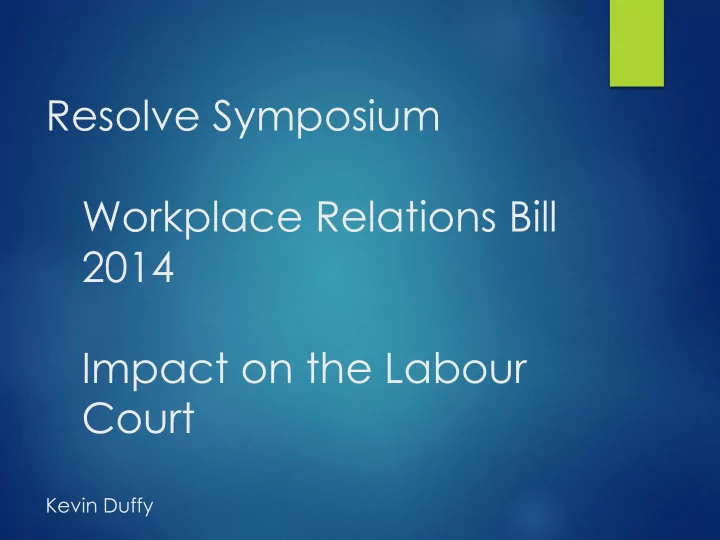

Resolve Symposium Workplace Relations Bill 2014 Impact on the Labour Court Kevin Duffy
Historical Role Established as an Industrial Relations Tribunal in 1946 Concerned with resolving and avoiding industrial disputes Established a reputation as a fair and impartial mediator Its Recommendations are validated by the agreement of the Parties Its stock and trade lies in the voluntary acceptance of its authority
The Labour Court “Not a Court of Law but a Court of Common Sense and Fair Dealing” “A Body Solely Concerned with the Resolution of Disputes by Peaceful Persuasion”
Employment Rights Jurisdiction Assigned Jurisdiction for Equal Pay Disputes in 1974 Equal Treatment in 1977 Organisation of Working Time 1997 Court also given Jurisdiction in Disputes under Nine other Employment Rights Statutes The Court’s Jurisdiction is Appellate Only
Employment Rights / Industrial Relations Currently Industrial Relations Referrals Account for 58% of Case Load Employment Rights Appeals Accounts for 42% of Referrals. Employment Rights Cases are Significantly more Demanding in Terms of Workload Employment Rights Cases Account for Between 60% - 70% of Workload
New Role for the Labour Court All Appeals from an Adjudication Office are to the Labour Court All Appellate Jurisdiction of EAT will Eventually Transfer Bulk of the Court’s Work will be Employment Rights Based Disputes Industrial Relation Role will Continue Unaffected Anticipated Increase in Caseload of Around 56% Principal Change will be in Appeals under Unfair Dismissals Acts (currently account for 90% of EAT Workload)
Structure of the Court Court will go from Three Divisions to Four Divisions There will be an Additional Deputy Chairman Provision for Chair / Deputy Chair to sit alone in Limited Circumstances
How Will it Work? 60% Increase in Cases 30% Increase in Resources Must retain Capacity to Respond to Urgent IR Cases
Assumptions Appeals Rate from First Instance Decisions will Remain Broadly the Same as at Present (between 10% -18% of cases are appealed) High Rate of Settlement in Unfair Dismissal Cases will Continue (Currently >60%) Availability of Mediation and Early Resolution will Increase the Rate of Settlements New Procedures will Expedite Hearings Benefits from Better use of Case Management
Rules on Procedures The Labour Court can make Rules Regulating its Procedures, including: - Bringing an appeal Conduct of hearing Representation Can Include all Matters Consequential or Incidental to the Conduct of a Hearing
Matters to be Covered by Rules It is anticipated that the Court will make Rules Covering : - Filing of Written Submissions Content of Submissions Witness Statements Case Management Procedures Giving of Directions to Parties
Mode of Procedure Present Procedures of the Court will Continue and Apply in all Cases Emphasis on Pre Hearing Procedures Requirement for Written Submissions Exchange of Submission before Hearing Emphasis on Case Management Parties Encouraged to Agree Non – Contentious Facts
What to Expect Court’s mode of Procedure very different to EAT A Hybrid between Inquisitorial and Adversarial Hearings will be Shorter Emphasis on Prehearing Procedures
Submission Case to be set out in a Written Submission To be Filed by Appellant Within Three Weeks of Initiation of Appeal State facts relied upon Summarise evidence to be relied upon State Number of witnesses Furnish to Other Side Replying Submission in Three Weeks Witness Statements Before Hearing
Objectives Reduce Waiting Times for Hearings Shorter Hearings Less Expensive Quick Decisions
Implications for the Court Bulk of Case Load will be Employment Rights Increase of >60% in Workload 44% Increase in Membership Cases Likely to take Longer Increase in Budget ??? Effectiveness of First Instance Adjudication Crucial
Biggest Challenge Retain its Primary Role as the Final Industrial Relation Peace maker in Disputes of Interest Provide an Efficient, Professional and Cost Effective Service to Workers and Employers in Resolving Disputes Concerning Employment Rights
Priorities for the Court Familiarisation Programme on new Jurisdictions Drafting Rules (s20 of 1946 Act as amended) Develop Work Organisation Programme to Deal with New Workload
Recommend
More recommend